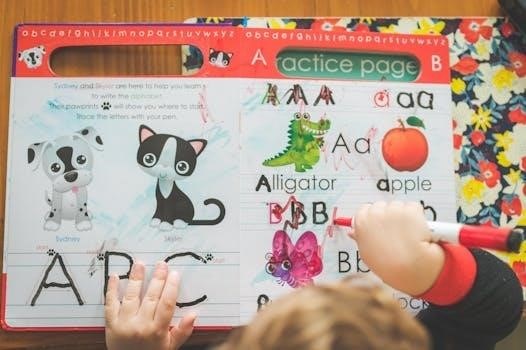Anatomy and physiology coloring workbooks serve as engaging study aids, offering a unique blend of visual learning and active participation․ They help reinforce complex concepts through coloring and labeling diagrams, enhancing understanding and retention․ These workbooks are ideal for students and enthusiasts alike․
Purpose of Coloring Workbooks in A&P
Coloring workbooks in Anatomy and Physiology (A&P) are designed to transform the often-challenging study of the human body into an interactive and enjoyable experience․ These workbooks serve as a practical tool for reinforcing A&P concepts, going beyond the traditional rote memorization techniques․ By engaging visual and kinesthetic learning modalities, they aim to solidify understanding through active participation․ The very act of coloring intricate diagrams of anatomical structures facilitates a deeper, more intuitive comprehension of their spatial relationships and functions․ Furthermore, the process of labeling parts and coloring different systems helps in creating a mental map of the human body․ This approach promotes visual associations which greatly assist in recalling complex information when needed․ These workbooks are not just about coloring; they are about engaging the student in active learning, making the study process more effective and less daunting․ They provide a hands-on approach that caters to various learning styles and promotes better retention of key anatomical and physiological knowledge․ The exercises also extend beyond simple coloring, with many workbooks including matching, true/false, and definition questions that help reinforce what was learned․
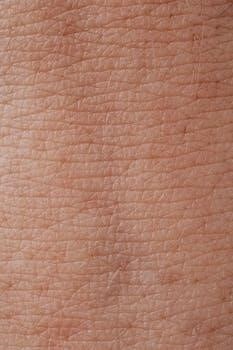
Structure and Content of A&P Coloring Workbooks
A&P coloring workbooks typically cover various body systems, using detailed illustrations and diagrams․ They include diverse exercises like labeling, matching, and questions, designed to enhance the learning process․ They also contain supporting text alongside the images․
Coverage of Body Systems
Anatomy and physiology coloring workbooks extensively cover all twelve major systems of the human body․ This comprehensive approach ensures that learners gain a thorough understanding of how each system functions individually and in relation to others․ The skeletal system, for instance, is explored through detailed illustrations of bones and joints, while the muscular system is depicted through diagrams of various muscle groups and their attachments․ The nervous system is examined with emphasis on the brain, spinal cord, and peripheral nerves․ Furthermore, the cardiovascular system is broken down into its components, including the heart, blood vessels, and blood circulation patterns․ The respiratory system, digestive system, urinary system, endocrine system, lymphatic system, integumentary system, and reproductive systems, are each meticulously covered․ These are presented in a way that helps to develop a solid foundation in anatomical structures and physiological processes․ Additionally, some workbooks include sections on cells and tissues, and even pregnancy and birth, offering a more holistic understanding of the human body․
Types of Exercises Included
Anatomy and physiology coloring workbooks incorporate a variety of exercises designed to engage different learning styles and enhance comprehension․ Besides the core coloring activities, these workbooks often feature labeling diagrams, where students identify specific anatomical structures․ Matching exercises test the learner’s ability to connect terms with their definitions or descriptions, promoting recall and understanding․ Completion exercises require students to fill in missing words or phrases, reinforcing key concepts․ True/false questions assess the student’s grasp of basic facts, while definition questions demand a deeper understanding of terminology․ There are also exercises that involve selecting from key choices, often presented as fill-in-the-blank activities․ These exercises can range from identifying phases of mitosis to selecting terms related to specific body systems․ Some workbooks offer visualization and application exercises, which challenge students to apply their knowledge to real-world scenarios․ This mix of exercise types helps to create a well-rounded learning experience that caters to different learning preferences․
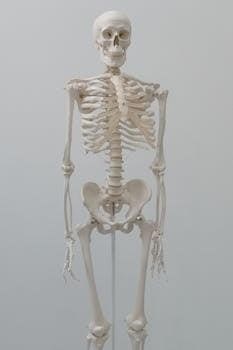
Use of Answer Keys in A&P Coloring Workbooks
Answer keys are crucial components of A&P coloring workbooks․ They provide immediate feedback, allowing students to check their work and reinforce their learning․ These keys support self-assessment and are a valuable resource․
Importance of Answer Keys
The inclusion of answer keys in anatomy and physiology coloring workbooks is paramount for effective learning․ These keys serve as essential tools for self-assessment, allowing students to immediately verify the accuracy of their work․ This instant feedback mechanism is crucial for reinforcing correct concepts and identifying areas that require further study․ Answer keys not only validate the coloring and labeling exercises but also provide a benchmark for understanding the complex structures and processes within the human body․ Students can confidently engage with the material, knowing they have a reliable resource to guide their learning journey․ The availability of answers promotes independent study and reduces reliance on external assistance․ It also empowers learners to track their progress and build confidence in their understanding․ Moreover, answer keys often include explanations, which delve deeper into the rationale behind each correct response, enhancing the overall educational value of the coloring workbook․ They transform the coloring activity into a more comprehensive learning experience․
Availability of Answer Keys
Answer keys for anatomy and physiology coloring workbooks are typically found in a few key locations, designed for easy access and convenience for the user․ Most commonly, these answer keys are included directly within the workbook itself, often located at the back of the book․ This placement ensures that students have immediate access to the answers without needing additional resources․ In some instances, publishers may provide answer keys as separate documents, either in print or as downloadable PDFs, especially if the workbook is part of a larger series or curriculum․ These digital versions can be easily accessed online, offering flexibility for users who prefer to study with digital devices․ Furthermore, some educational platforms or websites that sell these workbooks also offer supplementary materials, including answer keys, available for download․ It is always recommended to check the specific product details or the publisher’s website to ensure the availability and format of the answer key before purchasing a coloring workbook․ This accessibility is crucial for the effectiveness of the learning process․
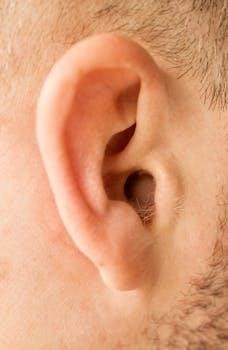
Benefits of Using A&P Coloring Workbooks
A&P coloring workbooks promote active learning through visual engagement, aiding concept reinforcement․ They make studying more interactive and enjoyable, improving memory and comprehension of complex anatomical structures and physiological processes․
Active Learning and Visual Association
Anatomy and physiology coloring workbooks actively engage learners by requiring them to physically interact with the material․ This hands-on approach fosters a deeper understanding compared to passive reading․ The act of coloring anatomical structures and physiological processes creates a visual association that helps in memorization and recall․ These workbooks often use detailed line artwork and supporting text, breaking down complex topics into manageable parts․ This method is particularly effective for visual learners who benefit from seeing and manipulating information․ The use of color also enhances the ability to distinguish between different structures and systems, making the learning process more intuitive․ By combining visual and kinesthetic learning, coloring workbooks promote a more holistic understanding of anatomy and physiology, facilitating a more lasting grasp of the subject matter․ The interactive nature of these workbooks also transforms what can be a challenging subject into a more engaging and enjoyable experience, which helps in maintaining student motivation․
Reinforcement of Concepts
Anatomy and physiology coloring workbooks are excellent tools for reinforcing concepts learned in lectures and textbooks․ The act of completing the exercises, such as labeling diagrams and matching terms, helps solidify understanding․ These activities provide a practical way to test and strengthen knowledge․ By engaging with the material in a different format, learners can identify gaps in their understanding and revisit areas that require further study․ The inclusion of various exercise types, like true/false and definition questions, further contributes to this reinforcement․ Furthermore, the use of answer keys in these workbooks allows students to immediately assess their progress and correct any misconceptions․ This immediate feedback loop is essential for efficient learning․ The comprehensive nature of these workbooks, covering all the major body systems, ensures a thorough review of the subject․ The use of coloring and visual association also helps to cement concepts in the long-term memory, which makes these workbooks a very effective means of knowledge reinforcement․
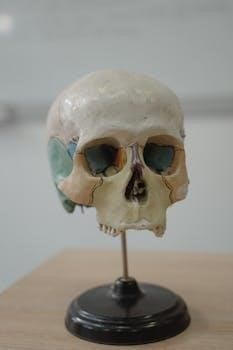
Specific Examples and Exercises
Anatomy and physiology coloring workbooks include a variety of exercises․ These may involve labeling diagrams, matching terms, and answering true/false or definition questions․ Such exercises actively engage learners, reinforcing their understanding of the material․
Labeling Diagrams and Matching Exercises
Within the realm of anatomy and physiology coloring workbooks, labeling diagrams and matching exercises are fundamental components designed to enhance learning․ These activities actively involve students in the material, promoting a deeper understanding of anatomical structures and physiological processes․ Labeling diagrams requires students to identify and name specific parts of the body, reinforcing their knowledge of anatomical terminology and spatial relationships․ This hands-on approach encourages visual learning and helps students create mental maps of complex systems․ Matching exercises, on the other hand, challenge students to connect terms with their correct definitions or descriptions, testing their comprehension of key concepts․ These exercises often involve matching anatomical structures with their functions or physiological processes with their related terms․ By engaging with these types of exercises, students not only memorize information but also develop a more comprehensive grasp of how different parts of the body work together․ The combination of labeling and matching exercises is crucial for providing a well-rounded approach to learning anatomy and physiology․
True/False and Definition Questions
In anatomy and physiology coloring workbooks, true/false and definition questions serve as critical tools for assessing comprehension and solidifying knowledge․ True/false questions require students to critically evaluate statements about anatomical structures or physiological processes, encouraging them to distinguish between correct and incorrect information․ This exercise sharpens their understanding of key concepts and helps them identify common misconceptions․ Definition questions, conversely, focus on testing students’ understanding of specific terms and their associated meanings․ These questions often require students to provide concise and accurate definitions of anatomical structures, physiological processes, or related terminology․ This helps to reinforce vocabulary and ensures that students can articulate the fundamental principles of anatomy and physiology․ By incorporating true/false and definition questions, coloring workbooks provide a well-rounded approach to learning, moving beyond visual exercises to test the student’s ability to apply their knowledge in a more critical and analytical way․ These question types are essential for reinforcing conceptual understanding and preparing students for more advanced studies in the field․
